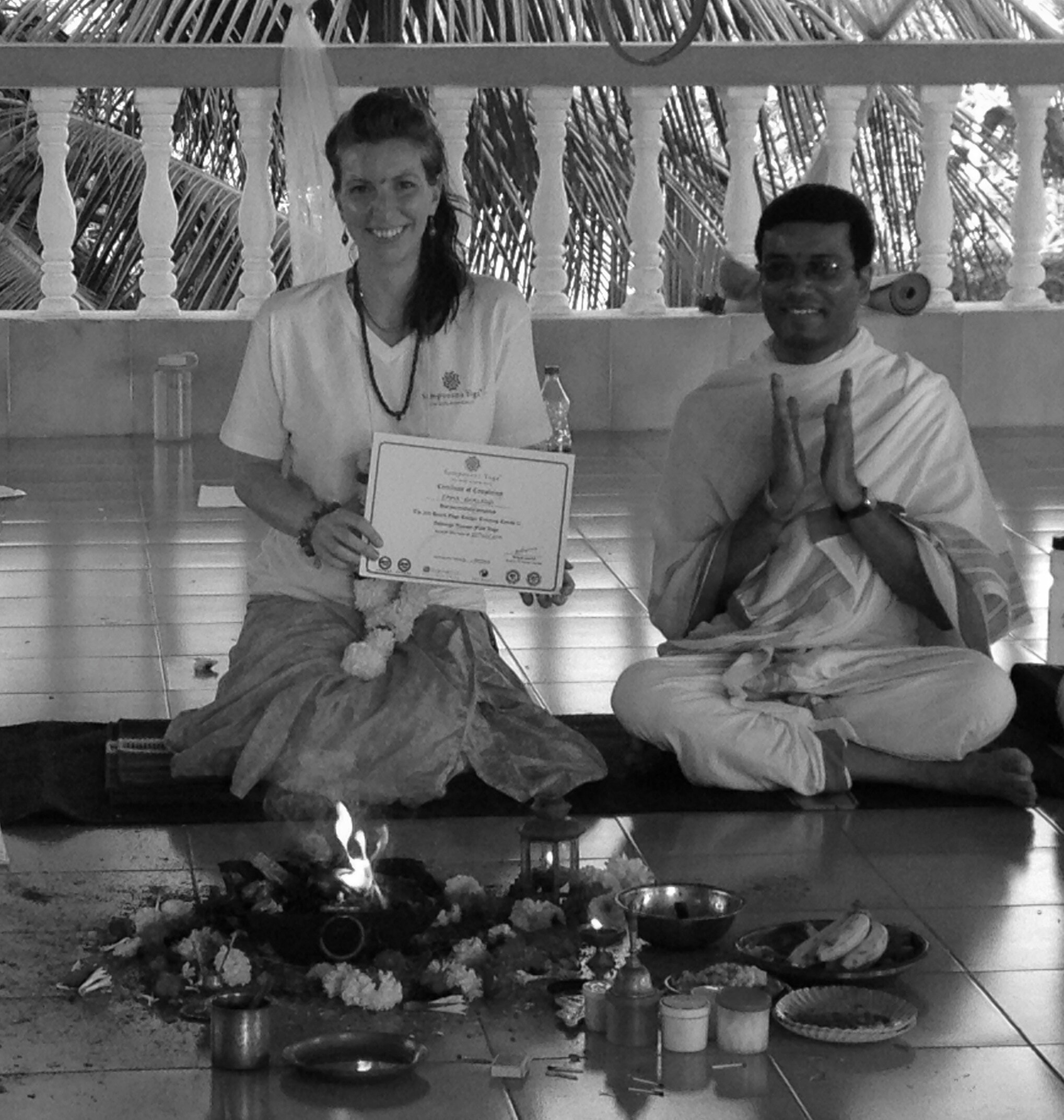Can I do yoga if I’m pregnant?
Yes! Yes! Yes! Absolutely. There’s some things you need to be aware of but there’s no reason why you can’t practice yoga the whole way through all three trimesters of your pregnancy to keep you strong and mobile and ready for the big birth day. The breath work you’ll learn too will be so powerful to help you feel connected to your body, throughout the whole experience.
Benefits of practicing yoga whilst pregnant
If you think about preparing your body and mind to get through a marathon, then you’re preparing yourself for giving birth. Giving birth is about being in tune with your body and yoga helps you to find and enhance this connection. Bringing awareness and a heightened sense of your own body, whilst exploring different postures. The deep breathing can be really powerful to help calm and quiet the body and mind to help give you focus and to relax the body and to help prepare yourself for birth and also to relieve pain during contractions. Your body also needs to be strong and flexible to endure the long, sleepless nights and the repetitive movements we go through once the baby arrives, for example, having a strong back to hold, carry rock your baby, repetitively bending over a changing table, etc. Being strong enough in the shoulders and upper body to hold the baby for feeding is really important too.
What to modify in yoga during pregnancy?
If you’re already used to doing yoga then continuing to practice throughout your pregnancy can be a great benefit for many reasons. There’s just a few things to adapt, as your body changes. If you’re brand new to yoga, then taking a beginner class or a more gentle practice like Hatha yoga may be a good way to help keep you strong and maintain mobility throughout your practice, as well as helping you to relax and find some ‘me time’. Or perhaps finding a local Pregnancy Yoga class will be just what you’re looking for. Yin Yoga is considered a gentle practice but make sure that you’re practicing it for the relaxation element and not to improve flexibility. Use props to avoid over-stretching instead. Whichever class you attend, it’s always worth getting to know your yoga teacher; explain you’re pregnant and at what stage and ask for advice if you’re unsure about anything.
The three trimesters….
During the first trimester, your body is getting used to lots of changes, including many a hormone, so it’s wise to take things easy in this first stage. Once you move into the second trimester, you should start to feel like you’re gaining some energy and perhaps feeling a little more like your usual self. You might, by this stage, be starting to show a bump too, so it’s time to make some space as you move through your practice. By the third trimester, you may well be starting to feel the weight of your growing bump and the pressure down below too. You may find you’re more tired and your energy levels aren’t what they used to be. Take it easy and as with all exercise, listen to your body.
How can I adapt my yoga practice whilst pregnant?
Increased flexiblity
Your flexibility will improve during pregnancy as your body releases hormones to allow your muscles to relax, allowing you to pass your baby through the birth canal. With this increased flexibility, it’s important that you don’t take advantage of this and push yourself further than you typically would. If anything, think about engaging muscles more in postures to build strength instead.
Give yourself space
If you picture yourself as 9 months pregnant from the get go, you’ll need to make some adjustments to your yoga practice but this will allow you to start adapting your practice for the next few months and also post-pregnancy too. For example, if you find yourself in a standing or seated posture with your feet together, you may actually take your feet hip width apart instead, allowing some space for your bump. Likewise, when you’re in folding postures, instead of folding forward and down, think how that particular forward-folding yoga pose might look at 9 months pregnant. Probably very different. So instead, think about using the forward folds to strengthen the back instead and working towards a slightly rounded spine in a forward fold instead of trying to go deep into a fold.
Avoid twists
Essentially try to avoid twists that compress the body, like Marichyasana C & D. Anything where you fold inwards and compress your chest, middle and belly. Instead, twist the opposite way to everyone else, so keep your belly and chest nice and open and free. Think about the space element again. If you can’t get into the posture at 9 months, then don’t do it at 4 months either.
Look after your pelvis!
This is a huge one to adjust to and one that you should try to do as a daily practice whenever you can as it can have a huge impact on your body later in life. In an ideal world we’d all have a neutral pelvis but the likelihood is that you either have very tight hamstrings that pulls your pelvis down, or you typically have a natural arch in your lower back which means your pelvis is pulled upwards at the back. If it’s the latter, then this only worsens as your baby bump grows. The baby pushes outwards at the front and so your lower back takes the pressure and compression. It can lead to lower back pain overtime if left uncorrected. Tucking your tail bone under and rounding your lower back can help to alleviate this a little, as well as stretching out your lower back in postures like Downward-facing dog (Adho Mukha Svasana) and Child’s pose (Balasana). Post-pregnancy, once you’re back up and running and are ready to start exercising, you can start to gently strengthen the front of the body/core to relieve pressure from the lower back and to correct the alignment of the pelvis, to avoid lower back pain later in life.
Going upside down / inversions during pregnancy
If this is something you’re used to doing on a regular basis then you can continue to do so, if it feels right for you, of course. As always listen to your body and take things a little easier than you usually would, whilst you’re pregnant. Some people avoid inversions in their first trimester and then start practicing again once they have some more energy in their second trimester. Just bear in mind that as you start to get bigger, your centre of gravity is going to be different. So headstands and handstands will feel different, but postures like shoulder-stand or feet up the wall can be a little more supportive.
Prop me up
Props can be a great help to give you more support in your yoga practice and especially when you’re pregnant. Prop yourself up with cushions, blocks or maybe invest in a yoga bolster. Blocks can help you to avoid over-stretching in the hips in seated postures; blocks can also help you come up a little higher in standing postures like Triangle pose (Utthita Trikonasana). Straps can help you reach towards your feet, instead of over-stretching your hands towards your toes, etc. Bolsters can be a good investment too as they can support you more comfortably. Feet up the wall (Viparita Karani) pose with a bolster on top of your feet can be a really lovely posture to rest in and take the pressure off your pelvis, especially if you’ve been on your feet all day.
Savasana
Typically the relaxation posture at the end of your practice/class; Savasana is where we lye on our back. However, when you’re pregnant, you may find lying on your side is a good alternative for Savasana. Ideally, try to lye on your left side, not your right side and support yourself with a block or bolster between your thighs.
Just breathe
For the days, when you don’t feel like moving much, just breathing deeply can bring a world of benefits. If you’re attending a yoga practice and just want to take it easy, then take it easy. If others are going into a posture that you don’t feel comfortable with or are unsure about, then just sit and breathe. Tuning into the breath can help deepen your connection with your body and can only help to increase your awareness of your body which will be so important when you’re in labour.
Whatever you choose to do, staying healthy and active is good for you and your baby. Feel free to get in touch to ask any questions.
Emma’s Personal Journey
I was 5 months pregnant when I started my Yoga Teacher Training. It was a decision I deliberated over for quite some time and I sought a lot of professional advice with the health and wellness industry, but it was something I wanted to do for myself for such a long time. I went into the Teacher Training knowing that if I felt unwell, too tired or was putting my baby at risk, in any way, that I would just stop and go home. I had a very difficult first trimester with severe morning sickness which lasted until late into the afternoon everyday. I felt tired constantly, not wanting to move or eat for fear of being sick. Thankfully, it literally stopped overnight as I went into my second trimester and I felt human once more.
My energy levels came back, along with my appetite and it felt like such a relief after 10 weeks of what felt like the longest hangover! The Teacher Training was tough and intensive. Days started at 5am and finished at 7pm. We’d have time for dinner at the end of the day and then do about an hour or so or theory homework and be in bed for 9pm. We did this 6 days a week for 6 weeks. It was tiring and exhausting but I felt I had the energy to continue through and I usually spent my Sunday off horizontal on the beach catching up with friends!
I felt I actually took more away from my experience than if I hadn’t have been pregnant. I knew the Ashtanga Practice very well prior to my Teacher Training and I used the experience to adapt to my changing body. I learnt to modify as my body changed and I fully embraced it. It’s something I go back to again and again, whenever I injure myself or are unwell, as well as bringing what I’ve learnt to others too. I meet people who are working with injuries or illnesses in their body and help them to adapt and modify their practice. It can be very frustrating to have an injury and it’s easy to think about what we cannot do. Instead we should celebrate what we can do and look to build strength in the parts of our bodies that are fully capable, all the time allowing our injuries to heal.


